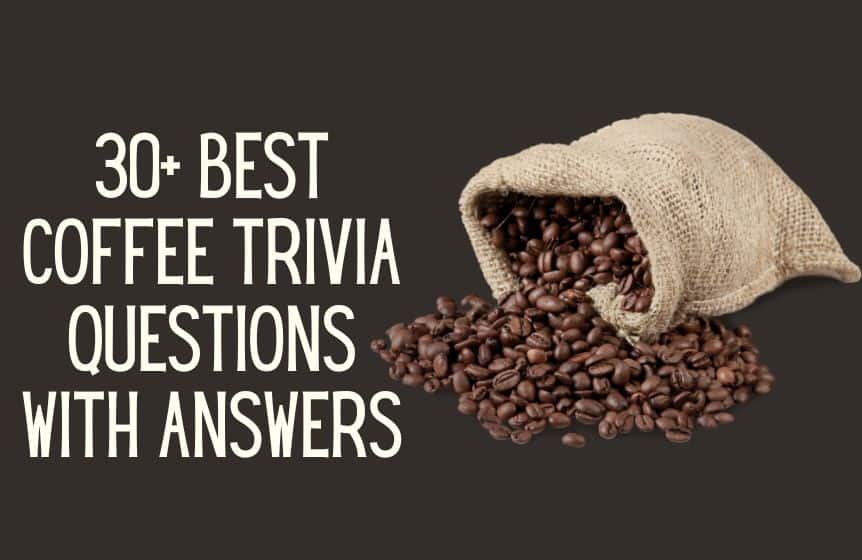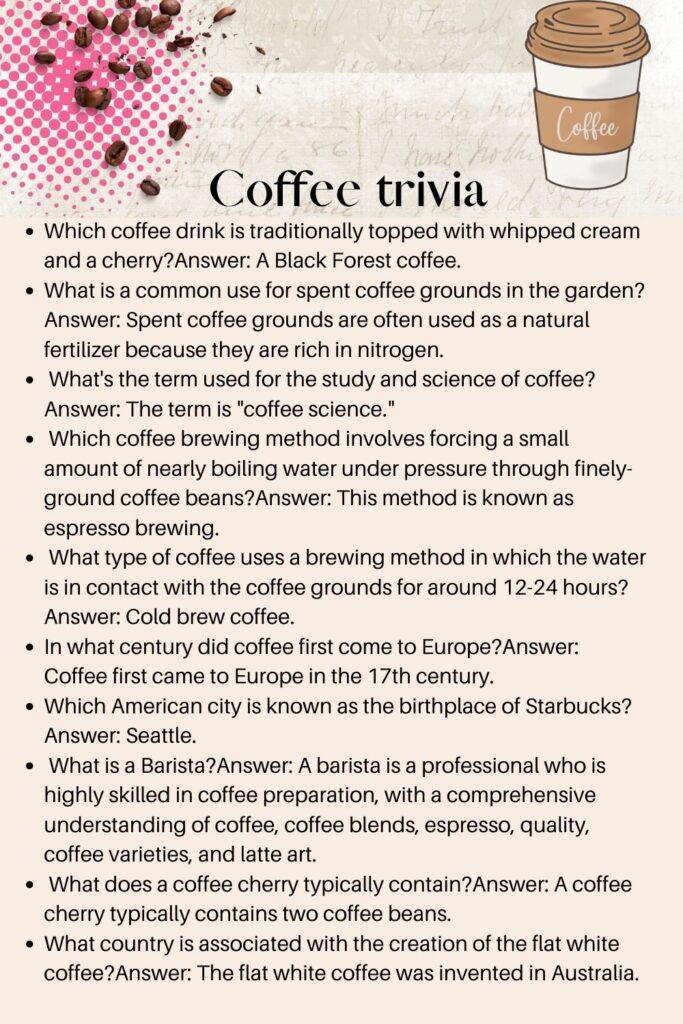Coffee, this wonderful, fragrant brew that so many of us start our day with, has a rich and fascinating history that extends across cultures and continents. Whether you’re an espresso enthusiast, a latte lover, or an admirer of all things caffeine, you’ll find a trove of fascinating facts and stories in our exploration of coffee trivia.
Discover little-known facts about your favorite beverage and impress your friends at your next coffee shop meet-up with your extensive coffee knowledge. So, grab your favorite cup of coffee, sit back, and let’s dive into the captivating world of coffee trivia!

Easy coffee trivia questions and answers
- What is the name of the process by which coffee beans are usually dried before being roasted?The process is called “curing.”
- Which Italian city is credited with the development of the espresso machine? Milan.
- Is white coffee lighter or stronger than regular coffee? White coffee is stronger than regular coffee as it is under-roasted and retains more caffeine.
- In the sitcom “Friends,” what is the name of the coffee shop where the characters frequently hang out? Central Perk.
- Which American city is known as the birthplace of Starbucks? Seattle.
- What is a Barista? A barista is a professional who is highly skilled in coffee preparation, with a comprehensive understanding of coffee, coffee blends, espresso, quality, coffee varieties, and latte art.
- What does a coffee cherry typically contain? A coffee cherry typically contains two coffee beans.
- What country is associated with the creation of the flat white coffee? The flat white coffee was invented in Australia.
- Which coffee drink is traditionally topped with whipped cream and a cherry? A Black Forest coffee.
- What is a common use for spent coffee grounds in the garden? Spent coffee grounds are often used as a natural fertilizer because they are rich in nitrogen.
- What’s the term used for the study and science of coffee? The term is “coffee science.”
- Which coffee brewing method involves forcing a small amount of nearly boiling water under pressure through finely-ground coffee beans? This method is known as espresso brewing.
- What type of coffee uses a brewing method in which the water is in contact with the coffee grounds for around 12-24 hours? Cold brew coffee.
- In what century did coffee first come to Europe? Coffee first came to Europe in the 17th century.

Hard coffee trivia and asnwers
- What plant does coffee come from? Coffee comes from a genus of plants known as Coffea. There are several species within this genus, but the two most commonly grown are Coffea arabica and Coffea robusta. These plants are native to tropical regions of Sub-Saharan Africa
- Which country produces the most coffee globally? As of September 2021, Brazil is the world’s largest producer of coffee, responsible for about a third of all coffee production globally.
- Can you use coffee grounds for anything else after brewing? Yes, coffee grounds can be reused in numerous ways. They can be used as a natural fertilizer for plants, a deodorizer, a natural abrasive cleaner, or even as an ingredient in homemade beauty products like body scrubs.
- In terms of total tons of coffee beans, where does the United States rank globally? While the U.S. is one of the largest consumers of coffee, it’s not a significant producer due to its mostly non-tropical climate. Hawaii is the only U.S. state that grows coffee commercially, especially the famous Kona coffee.
- Where can coffee lovers find the world’s most expensive coffee? The world’s most expensive coffee, Kopi Luwak, comes from Indonesia. It’s unique because it’s made from coffee cherries that have been eaten and excreted by the Asian palm civet. The beans are collected from the feces, cleaned, roasted, and then brewed.
- How many cups of coffee does the average American drink in a day? The average American coffee drinker consumes around 3 cups of coffee per day. This figure can vary depending on factors such as age, occupation, and personal preferences.
- How many coffee shops are there approximately in the United States? There were over 37,000 coffee shops in the United States. This includes both large chains like Starbucks and Dunkin’ as well as independent cafes.
- What are coffee cherries? Coffee cherries are the fruit of the coffee plant. They are small, round, and usually red or purple when ripe. Each cherry typically contains two seeds, which we know as coffee beans.
- What is Irish coffee? Irish coffee is a cocktail consisting of hot coffee, Irish whiskey, sugar, and topped with a layer of cream. It was originally created to warm up American tourists in Ireland during the cold, wintry flights.
- How many milligrams of caffeine are there in a typical cup of coffee? A standard 8 ounce cup of coffee contains about 95 milligrams of caffeine. This can vary depending on factors like the type of coffee bean, how it was roasted, and how it was brewed.
- How much caffeine is there in a cup of decaffeinated coffee? Despite the name, decaffeinated coffee is not completely free of caffeine. A standard 8 ounce cup of decaffeinated coffee typically contains about 2 to 15 milligrams of caffeine, a significantly smaller amount compared to regular coffee.
- What does the term “cup of joe” mean, and where did it originate? “Cup of Joe” is a colloquial term for a cup of coffee. The exact origins of the phrase are unclear, but one popular theory suggests it may be linked to Josephus Daniels, the Secretary of the Navy who abolished alcohol on U.S. Navy ships in the early 20th century, making coffee the strongest drink available to sailors.
More coffee trivia
- What is a French press and how does it work? A French press, also known as a plunger or press pot, is a simple yet effective method of brewing coffee. It consists of a cylindrical beaker, usually made of glass, a plunger, and a metal or nylon mesh filter. Ground coffee is steeped in hot water within the beaker, and then the plunger is pressed down, separating the grounds from the brewed coffee.
- What is the Asian palm civet’s role in coffee production? The Asian palm civet plays a unique role in the production of Kopi Luwak coffee, one of the world’s most expensive coffees. The civet eats coffee cherries for their flesh, and in the process, the seeds (or coffee beans) pass through its digestive system. The beans are then collected from the civet’s feces, thoroughly cleaned, and roasted.
- How do you make a cup of coffee using a French press? To make coffee with a French press, first add coarse ground coffee to the carafe, typically a 1:15 coffee-to-water ratio. Then pour in hot water just off the boil, stir, and let it steep for about 4 minutes. After steeping, slowly press the plunger down to separate the grounds from the liquid. Your coffee is then ready to be poured and enjoyed!
- What is the first known type of coffee beverage? The first known coffee beverage was likely a type of wine made from the fermented pulp of coffee cherries. It wasn’t until later that the beans were roasted and brewed as they are today. This early coffee wine was used in Ethiopia as early as the 9th century.
- Who invented the first espresso machine and when?The first patent for an espresso machine was issued to Angelo Moriondo of Turin, Italy, in 1884. However, the machine as we know it today was perfected by Luigi Bezzera and Desiderio Pavoni in the early 20th century.
- How much caffeine is in a shot of espresso?Answer: Despite its strong flavor and reputation, a standard shot of espresso (about 1 oz) typically contains about 63 milligrams of caffeine,less than a standard 8 oz cup of coffee. This is because the brewing time of espresso is much shorter, resulting in less caffeine extraction.
- Is coffee a popular drink worldwide? Absolutely. Coffee is enjoyed by millions of people around the world every day, making it one of the most popular beverages globally. It’s deeply ingrained in many cultures and societies.
- Which French colony became a significant coffee producer in the 19th century due to its ideal climate and conditions? Vietnam, a French colony from the mid-19th to mid-20th century, became a major coffee producer. The French introduced coffee cultivation here, and thanks to the country’s ideal climate and high-altitude regions, it thrived. Today, Vietnam is the world’s second-largest producer of coffee after Brazil.
- What is Kona coffee? Kona coffee is a type of coffee cultivated on the slopes of Mauna Loa and Hualalai in the North and South Kona Districts of the Big Island of Hawaii. It’s known for its rich flavor, low acidity, and aromatic qualities.
- What is a coffee roaster? A coffee roaster is a machine used to transform the green coffee beans into roasted coffee products. The process is known as roasting, which brings out the aroma and flavor locked inside the coffee beans.
- What is Arabica coffee? Arabica coffee is a type of coffee made from the beans of the Coffea arabica plant. It’s the most widely consumed type of coffee in the world, known for its delicate flavor and lower caffeine content compared to Robusta coffee.
- How many American adults are regular coffee drinkers? According to the National Coffee Association, as of 2020, about 62% of American adults drink coffee daily, showcasing a strong coffee culture in the United States.
- When was coffee first introduced to Europe? Coffee was introduced to Europe in the 17th century, primarily through trade with the Ottoman Empire. The first coffeehouses opened in Italy and England in the mid-17th century and quickly became popular social gathering spots.
- Is it true that coffee is the second most traded commodity in the world? Yes, coffee is often cited as the second most traded commodity globally, following crude oil. This statement is based on the total value of goods traded.
- Which famous German composer wrote a mini comic opera about a woman’s addiction to coffee? Johann Sebastian Bach composed the “Coffee Cantata” in the 1730s. This humorous operatic work tells the story of a young woman’s love for coffee and her father’s attempts to curb her addiction.
- What is the significance of green coffee beans in the coffee industry? Green coffee beans are the raw, unroasted seeds of the Coffea plant. They’re crucial in the coffee industry as roasting them is what brings out the flavor and aroma that makes coffee so beloved.
- How did coffee consumption influence the American Revolution? During the American Revolution, drinking coffee became an act of patriotic defiance after the Boston Tea Party in 1773. As colonists boycotted British tea, coffee became a popular replacement and has remained a favorite American beverage since.
- What type of energy is typically used to roast coffee beans? Natural gas is the most commonly used energy source for roasting coffee beans in commercial roasting operations due to its efficiency and control over temperature.
- What is Kopi Luwak coffee and why is it so expensive? Kopi Luwak, or civet coffee, is one of the world’s most expensive and controversial coffee varieties. It’s produced from coffee beans that have been eaten and then excreted by the Asian palm civet. The beans are then collected, cleaned, and roasted. Its high price is due to the unique (and controversial) process and the rarity of the beans.
- Which U.S. Navy ship is named after a word synonymous with coffee? The USS Parche (SSN-683), a Sturgeon-class submarine, was named after the French word for “coffee.” Parche is a term used in the French West Indies for the top layer of a cup of coffee.
- What’s a great way to re-purpose used coffee grounds? Used coffee grounds can be repurposed in many ways, such as compost for gardens, an exfoliating body scrub, a deodorizer for your fridge or freezer, or even to deter pests from your garden.
- What is decaf coffee, and how is the caffeine removed? Decaf, or decaffeinated coffee, is coffee from which most of the caffeine has been removed. This can be done through several methods, including using water, organic solvents, or supercritical carbon dioxide. Despite the process, decaf coffee still retains a small amount of caffeine.
- What’s the “Coffee Cantata” and who composed it? The “Coffee Cantata” is a mini comic opera composed by Johann Sebastian Bach. The narrative revolves around a young woman’s love for coffee and her father’s disapproval of her obsession.
- What is unique about the people of Finland in terms of coffee? Finland has the highest coffee consumption per capita in the world. On average, each person in Finland consumes about 12 kg of coffee per year, according to the International Coffee Organization.
- What is the stimulating effect of coffee? The stimulating effect of coffee comes from caffeine, a natural compound that blocks adenosine receptors in the brain, preventing the onset of drowsiness. It can increase alertness, reduce fatigue, and improve concentration.
- Does the caffeine content differ based on the type of coffee bean? Yes, the caffeine content can vary based on the type of coffee bean. Generally, Robusta beans contain almost twice as much caffeine as Arabica beans.
- Which among the US states consume the most coffee? New York state reportedly had the highest coffee consumption, largely due to the significant number of coffee shops and high population in New York City.
- How many pounds of coffee beans are needed to make a pound of roasted coffee? It takes approximately 1.2 pounds of green coffee beans to produce a pound of roasted coffee. This is because the beans lose weight during the roasting process due to moisture loss.
- Who is the top exporter of coffee? Brazil is the world’s top exporter of coffee, accounting for around a third of all coffee production globally.
- How is Italian coffee different from other coffee? Italian coffee often refers to espresso, which is served in smaller, stronger amounts compared to typical American coffee. Italy is also known for coffee drinks like cappuccino, macchiato, and latte, which incorporate steamed milk and foam.
- What would you recommend to a coffee aficionado visiting Italy? When in Italy, a coffee aficionado should try a classic Italian espresso, have a cappuccino (only for breakfast), and enjoy a ristretto, which is an even more concentrated espresso. Also, do not miss visiting traditional coffee houses, like Caffè Florian in Venice, the oldest cafe in Italy.
- How much coffee does the average American drink daily? The average American coffee drinker consumes about 3 cups of coffee per day.
- Where was the first coffee tree discovered? The coffee tree is believed to have been first discovered in the Ethiopian region of Kaffa. According to legend, a goat herder named Kaldi first noticed the invigorating effects of the plant when his goats ate the berries.
- How much coffee does a single coffee plant produce on average? On average, a single coffee plant produces enough coffee cherries each year for about one pound of roasted coffee.
Related : Best coffee names

Fun facts about coffee
- Coffee was discovered by a goat herder in Ethiopia in the 9th century.
- The term “cup of joe” originated from American servicemen (GI Joes) in WWII being known to consume a lot of coffee.
- Irish coffee was actually invented to warm up cold American plane passengers leaving from Ireland.
- There are two main types of coffee beans that we consume: Arabica and Robusta. Arabica accounts for the majority of the world’s coffee production.
- The coffee “bean” is actually the seed of the coffee plant and is found inside the coffee fruit, often called a cherry.
- The world’s most expensive coffee can cost more than $600 a pound. It’s called Kopi Luwak, and it is made from coffee cherries eaten and then excreted by the Asian palm civet.
- A coffee plant can live up to 200 years. When grown in optimal conditions, it can live a very long time.
- Coffee was first brought to Europe by the Ottoman Empire in the 15th century.
- The largest coffee producer in the world is Brazil, producing around 1/3rd of the world’s coffee.
- Finland is the world’s biggest coffee consumer per capita. They consume 12 kg of coffee per person annually!
- Decaffeinated coffee isn’t completely caffeine-free. A decaf cup of coffee generally contains between 2 and 15 milligrams of caffeine.
- Dark roast coffees actually have less caffeine than lighter breakfast blends. The longer coffee beans are roasted, the more caffeine is burned off.
- Espresso was invented in Italy in the early 20th century as a way to reduce the brew time, hence the name “espresso,” which means “fast” in Italian.
- Coffee is the second most traded commodity in the world, only behind crude oil.
- George Washington invented instant coffee. Not the first President of the United States, but a Belgian man named George Washington living in Guatemala in the early 20th century.
- The largest cup of coffee ever was brewed in July 2014 in South Korea. It was over 3,700 gallons.
- The first webcam was created in Cambridge to check the status of a coffee pot.
- Before coffee became widely available, the popular breakfast drink was beer.
- In 1675, the King of England, King Charles II, banned coffee shops because he thought that that’s where people were conspiring against him.
- The lethal dose of caffeine is roughly 100 cups of coffee.
We hope you’ve enjoyed this enlightening journey through coffee trivia.
There’s so much more to your morning brew than meets the eye, from its historical origins to its modern-day significance. Whether you’re a casual coffee drinker or a full-on aficionado, there’s always something new to learn in the rich world of coffee.
Thanks for joining us, and remember, every cup of coffee holds a story.
Stay curious and keep exploring the fascinating world of coffee trivia!
Was this helpful?
Good job! Please give your positive feedback
How could we improve this post? Please Help us.



